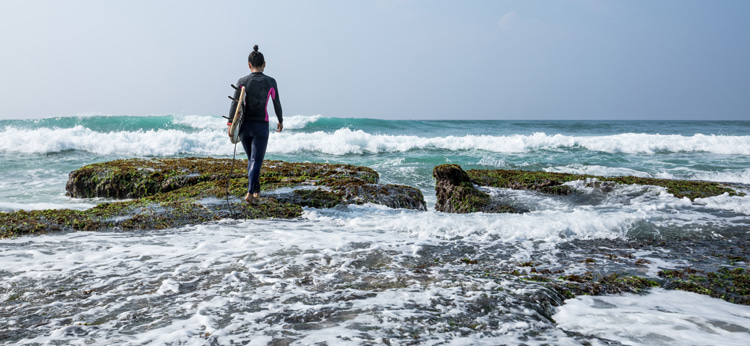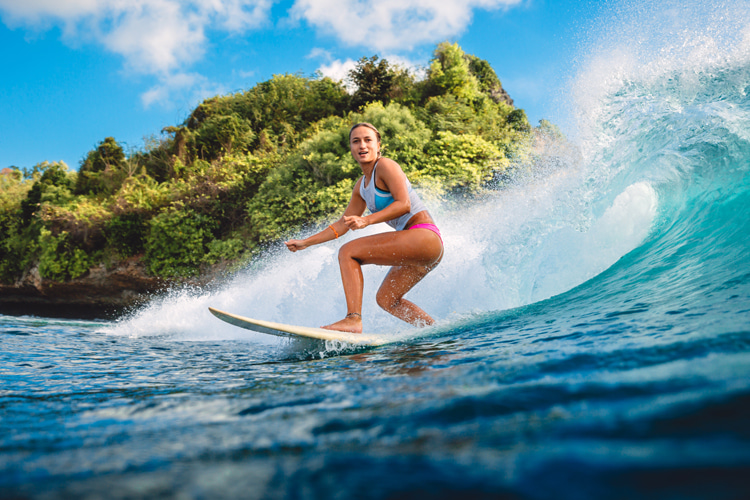A recent analysis of globally recognized surf locations and Marine Protected Areas (MPAs) found that nearly two-thirds of surf spots are not formally protected.
The study, published in the scientific journal Frontiers in Marine Science, was co-authored by Conservation International's Kellee Koenig, senior geographic information system (GIS) manager/cartographer, Jack Kittinger, vice president in the Center for Oceans, and Nik Strong-Cvetich, Save the Waves CEO.
The work was led by Dan Reineman of the Environmental Science and Research Program at California State University Channel Islands.
The results identify an opportunity for the surf and conservation communities to join together in an effort to protect and conserve these culturally significant areas that are key for biodiversity and economies.

Surprising Results
The analysis surveyed more than 3,700 surf locations around the world, with data provided by the global surf forecasting company Surfline.
It found that surf breaks are globally distributed (3,755 distinct surf breaks across 93 countries).
Also, six countries (USA, Australia, Brazil, Mexico, Japan, and France) account for 59 percent of the global total.
The study also reveals that 50 countries contain ten or more surf breaks.
Some surf spots are already situated within - and more are situated near - existing protected areas, but roughly three-fifths of all surf breaks are not within MPAs.
Finally, more than 25 percent of all surf breaks are within five kilometers of a Key Biodiversity Area (KBA).
"We're losing ocean biodiversity rapidly due to climate change, overfishing, and pollution - these threats are getting more intense every year," notes Kittinger.
"The proximity of surf breaks to areas with critical habitats and biodiversity creates a unique opportunity to implement a network of protected surf locations that will also support the survival of coastal ecosystems and the important species they harbor."
Despite the significant benefits that surf breaks provide to the environment, they - and their surrounding ecosystems - are under threat from the impacts of climate change, sea-level rise, coastal development, pollution, and coral reef degradation.
"These results give conservation organizations another tool for their toolbox," added Reineman.
"Instead of just focusing on biodiversity protection for its own sake, they can also focus on surf break protection - and use the culturally and economically significant sport of surfing to increase protections for biodiversity, also."
Marine Protected Areas Generate Revenue
The development of a new model that could guide ocean and coastal conservation and mobilize the surfing community - a group that often cares deeply about the health of the ocean - has the potential to engage the world's 34 million surfers to support long-term health of these ecosystems.
In 2019, Conservation International and Save The Waves Coalition joined forces to create the Surf Conservation Partnership.
Its aim is to mobilize surfing communities on a global scale and protect areas where outstanding surfing waves and the most biologically diverse marine and coastal ecosystems overlap.
The goal? To sustainably manage millions of hectares of coral reefs, coastal forests, and other critical habitats in areas that otherwise would not be conserved.
"We've found surfers value this type of conservation partnership because it enables them to be part of a process that protects the waves they care about, they are passionate and energized and dedicated to the long-term sustainability of these areas," underlined Strong-Cvetich, co-author and CEO of Save the Waves.
In addition to their biodiversity benefits, surf breaks and related tourism generate an average of $31-65 billion annually, and participants are often willing to pay more for sustainable tourism opportunities.
"Not only are many of these areas important to conserve for biodiversity, but they are also a force in the economies of communities around the world," states Koenig.
Surf conservation creates a unique opportunity to improve the health of the ocean and support the livelihoods of people."
To help raise awareness of the importance of waves, Conservation International recently released "The Wave," the newest addition to its award-winning "Nature is Speaking" series.
The film is narrated by actor, Hawaiian-native, and ocean sustainability advocate Jason Momoa.
It highlights the urgent need to protect and conserve the global ocean for the benefit of humanity.
